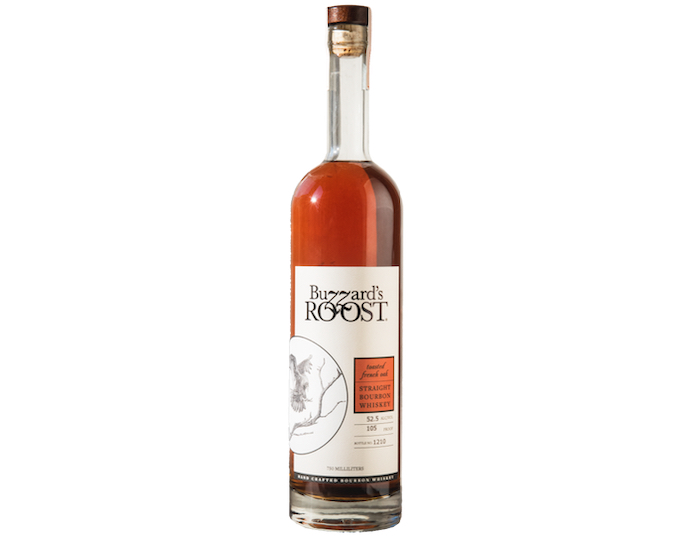Editor’s Note: These whiskeys were provided to us as review samples by Buzzard’s Roost. This in no way, per our editorial policies, influenced the final outcome of this review. It should also be noted that by clicking the buy link towards the bottom of this review our site receives a small referral payment which helps to support, but not influence, our editorial and other costs.
Launched in 2019 and helmed by Judy Hollis Jones, co-founder and CEO, Buzzard’s Roost is one of the few women owned and led whiskey producers in the nation. The company began by launching a series “re-barreled” rye whiskies. Jason Brauner is the master blender, and he selects the base whiskies from pre-aged whiskies from MGP in Lawrenceburg, Indiana, a large distiller responsible for quite a few rye-based whiskies. Today the secondary aging takes place at Bardstown Bourbon Company. Brauner made a name for himself launching Bourbons Bistro in Louisville, Kentucky, a restaurant known for its extensive bourbon collection and barrel selection. Recently, Jones and Brauner have branched out, exploring French oak re-barreled bourbon and barrel strength releases.
Re-barreling is when aged whiskies are aged further in new barrels. It is essentially a form of finishing, where whiskies are aged further in a different barrel to add character. Re-barreling is popular with hobbyists, who use countertop-sized new American oak casks to age moonshine or to improve the quality of a liter or two of inexpensive whiskey. It is unusual to see it associated with commercial releases, which more commonly undergo finishing in full sized used barrels or casks that held a different type of alcohol, such as Sherry or tequila.
To further complicate their process, Buzzard’s Roost took the unusual and difficult to manage choice of using the lightest char for the re-barreling oak, Char #1. This is rarely used in American whiskey. What do lightly charred barrels bring to the party? The flavor and textural impact are different. The light charring means the wood is closer to what is used for wine – with all the tannins, astringency, and unique flavor profile this entails. This also means less of the classic “bourbon” notes imparted by wood sugars (vanilla, caramel, and toast), though since Buzzard’s Roost is starting with pre-aged whiskeys, don’t expect them to be lacking in flavor. Proper seasoning and toasting of the wood before the brief char is imperative to avoid harsh flavors and textures. Short aging periods in these barrels also allow the whiskey to pick up distinctive aromatic profiles before the texture begins to change.
On tap, we have two new releases: the Buzzard’s Roost Toasted French Oak Straight Bourbon Whiskey and the Buzzard’s Roost Barrel Strength Straight Rye Whiskey. The former was re-barreled in French oak from Limousin, known for its large grain and nuanced yet tannic flavor profile. It’s an unusual choice for bourbon and is most often used for aging Cognac and Sherry. The latter whiskey is the first Barrel Strength release from Buzzard’s Roost, though at 57.5% ABV, this is not an aggressive barrel strength. The whiskies have limited distribution at this time and are available in Kentucky, Massachusetts, and a handful of other states.

Tasting Notes: Buzzard’s Roost Toasted French Oak Straight Bourbon Whiskey
Vital Stats: 5-year-old whiskey re-barreled in French oak, 52.5% ABV, mash bill: 74% corn, 21% rye, and 5% malted barley, SRP $85/750ml bottle.
Appearance: The Buzzard’s Roost Straight Bourbon Whiskey is a deep orange-amber color.
Nose: The nose is strongly spiced with a pungent note of freshly chopped oak, clove, and dried grass. There is a hint of nail polish remover, whole wheat toast, and ripe green apples. This is more potently perfumed of the two.
Palate: This is sugary on the palate with a moderately grippy mouthfeel and peppery alcohol. It feels like it’s evaporating on your tongue. There are notes of sandalwood, buckwheat, toasted brown rice, and dried apples. It is not overly fruity or floral, but more driven by grain and exotic spice notes. The finish is long and mellow, with notes of dried apples, toasted wheat bread, orange oil, and raw honey.
Score: 4/5

Tasting Notes: Buzzard’s Roost Barrel Strength Straight Rye Whiskey
Vital Stats: 4-year-old whiskey re-barreled in Char #1 new American oak, 57.5% ABV, mash bill: at least 51% rye, SRP $85/750ml bottle.
Appearance: This whiskey was a touch lighter in color than the non-barrel strength version and is a moderate amber color.
Nose: The nose here seems more saccharine and neutral, with notes of pear juice, toasted white bread, caramel corn, popcorn, and Queen Anne’s lace. The sweetness opens up into notes of caramel, candied pecans, milky tea, Lyle’s Golden Syrup, fresh dill, and chalk dust.
Palate: Peppery and medium to full bodied, this is creamy on the palate but with a zippiness from the alcohol. I taste toasted rye bread, fresh baked whole wheat bread, caramel, and burnt sugar. It’s nicely peppery on the tongue, with sweet and bitter aromas. Despite its high proof, it feels smooth on the palate. The caramel note carries through the finish alongside notes of molasses. It’s not overly sweet and has very gentle tannins and a moderately long finish. With water, I taste ripe watermelon and maraschino cherries.
Score: 4/5
Final Thoughts
These are solid whiskies with deep and complex aromatics that stretch beyond fruit and spice. I had a slight personal preference for the Buzzard’s Roost Straight Bourbon Whiskey since the Buzzard’s Roost Barrel Strength Straight Rye Whiskey is a touch aggressive on the palate. The former seems more complete, while the latter would make a fine sipping whiskey for the more brave of heart.








